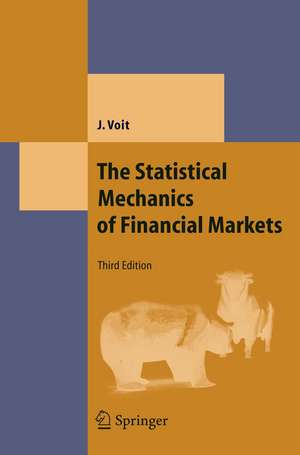The Statistical Mechanics of Financial Markets: Theoretical and Mathematical Physics
Autor Johannes Voiten Limba Engleză Paperback – 19 oct 2010
| Toate formatele și edițiile | Preț | Express |
|---|---|---|
| Paperback (1) | 427.11 lei 6-8 săpt. | |
| Springer Berlin, Heidelberg – 19 oct 2010 | 427.11 lei 6-8 săpt. | |
| Hardback (1) | 537.46 lei 6-8 săpt. | |
| Springer Berlin, Heidelberg – 21 oct 2005 | 537.46 lei 6-8 săpt. |
Din seria Theoretical and Mathematical Physics
- 20%
 Preț: 697.22 lei
Preț: 697.22 lei - 18%
 Preț: 744.84 lei
Preț: 744.84 lei - 20%
 Preț: 699.50 lei
Preț: 699.50 lei -
 Preț: 396.82 lei
Preț: 396.82 lei - 15%
 Preț: 721.06 lei
Preț: 721.06 lei - 18%
 Preț: 1120.68 lei
Preț: 1120.68 lei -
 Preț: 398.35 lei
Preț: 398.35 lei - 15%
 Preț: 643.65 lei
Preț: 643.65 lei - 15%
 Preț: 508.60 lei
Preț: 508.60 lei - 20%
 Preț: 652.54 lei
Preț: 652.54 lei - 15%
 Preț: 646.75 lei
Preț: 646.75 lei - 15%
 Preț: 654.12 lei
Preț: 654.12 lei - 15%
 Preț: 649.87 lei
Preț: 649.87 lei -
 Preț: 396.24 lei
Preț: 396.24 lei - 15%
 Preț: 653.14 lei
Preț: 653.14 lei - 18%
 Preț: 960.78 lei
Preț: 960.78 lei - 15%
 Preț: 529.92 lei
Preț: 529.92 lei - 18%
 Preț: 1127.78 lei
Preț: 1127.78 lei - 18%
 Preț: 1548.71 lei
Preț: 1548.71 lei - 15%
 Preț: 551.53 lei
Preț: 551.53 lei - 18%
 Preț: 1002.75 lei
Preț: 1002.75 lei -
 Preț: 396.02 lei
Preț: 396.02 lei - 15%
 Preț: 648.89 lei
Preț: 648.89 lei - 18%
 Preț: 783.35 lei
Preț: 783.35 lei - 18%
 Preț: 973.38 lei
Preț: 973.38 lei - 18%
 Preț: 907.90 lei
Preț: 907.90 lei - 15%
 Preț: 655.78 lei
Preț: 655.78 lei - 18%
 Preț: 1118.93 lei
Preț: 1118.93 lei -
 Preț: 390.25 lei
Preț: 390.25 lei - 15%
 Preț: 663.79 lei
Preț: 663.79 lei - 15%
 Preț: 653.79 lei
Preț: 653.79 lei - 15%
 Preț: 645.28 lei
Preț: 645.28 lei - 15%
 Preț: 604.23 lei
Preț: 604.23 lei - 15%
 Preț: 639.25 lei
Preț: 639.25 lei - 15%
 Preț: 590.81 lei
Preț: 590.81 lei -
 Preț: 395.25 lei
Preț: 395.25 lei - 15%
 Preț: 589.33 lei
Preț: 589.33 lei - 19%
 Preț: 543.19 lei
Preț: 543.19 lei - 15%
 Preț: 594.24 lei
Preț: 594.24 lei - 18%
 Preț: 911.17 lei
Preț: 911.17 lei - 18%
 Preț: 957.75 lei
Preț: 957.75 lei -
 Preț: 409.13 lei
Preț: 409.13 lei - 15%
 Preț: 532.23 lei
Preț: 532.23 lei
Preț: 427.11 lei
Nou
Puncte Express: 641
Preț estimativ în valută:
81.73€ • 87.40$ • 68.14£
81.73€ • 87.40$ • 68.14£
Carte tipărită la comandă
Livrare economică 18 aprilie-02 mai
Preluare comenzi: 021 569.72.76
Specificații
ISBN-13: 9783642065781
ISBN-10: 3642065783
Pagini: 396
Ilustrații: XVI, 378 p.
Dimensiuni: 155 x 235 x 21 mm
Greutate: 0.55 kg
Ediția:Softcover reprint of hardcover 3rd ed. 2005
Editura: Springer Berlin, Heidelberg
Colecția Springer
Seria Theoretical and Mathematical Physics
Locul publicării:Berlin, Heidelberg, Germany
ISBN-10: 3642065783
Pagini: 396
Ilustrații: XVI, 378 p.
Dimensiuni: 155 x 235 x 21 mm
Greutate: 0.55 kg
Ediția:Softcover reprint of hardcover 3rd ed. 2005
Editura: Springer Berlin, Heidelberg
Colecția Springer
Seria Theoretical and Mathematical Physics
Locul publicării:Berlin, Heidelberg, Germany
Public țintă
ResearchCuprins
Basic Information on Capital Markets.- Random Walks in Finance and Physics.- The Black-Scholes Theory of Option Prices.- Scaling in Financial Data and in Physics.- Turbulence and Foreign Exchange Markets.- Derivative Pricing Beyond Black—Scholes.- Microscopic Market Models.- Theory of Stock Exchange Crashes.- Risk Management.- Economic and Regulatory Capital for Financial Institutions.
Recenzii
From the reviews of the third edition:
"An excellent job of integrating many of the most important themes from econophysics in a relatively small volume. … The book serves its purpose, as a textbook on econophysics, superbly and one can tell that it developed from a course of lectures. The book is written with extreme clarity and an excellent pedagogical style. For philosophers who wish to acquaint themselves with the field of econophysics (beyond a superficial level), this is the book to invest in." (Dean Rickles, Studies in History and Philosophy of Modern Physics, Vol. 38, 2007)
"An excellent job of integrating many of the most important themes from econophysics in a relatively small volume. … The book serves its purpose, as a textbook on econophysics, superbly and one can tell that it developed from a course of lectures. The book is written with extreme clarity and an excellent pedagogical style. For philosophers who wish to acquaint themselves with the field of econophysics (beyond a superficial level), this is the book to invest in." (Dean Rickles, Studies in History and Philosophy of Modern Physics, Vol. 38, 2007)
Textul de pe ultima copertă
This highly praised introductory treatment describes the parallels between statistical physics and finance - both those established in the 100-year long interaction between these disciplines, as well as new research results on financial markets.
The random-walk technique, well known in physics, is also the basic model in finance, upon which are built, for example, the Black-Scholes theory of option pricing and hedging, plus methods of portfolio optimization. Here the underlying assumptions are assessed critically. Using empirical financial data and analogies to physical models such as fluid flows, turbulence, or superdiffusion, the book develops a more accurate description of financial markets based on random walks. With this approach, novel methods for derivative pricing and risk management can be formulated. Computer simulations of interacting-agent models provide insight into the mechanisms underlying unconventional price dynamics. It is shown that stock exchange crashes can be modelled in ways analogous to phase transitions and earthquakes, and sometimes have even been predicted successfully.
This third edition of The Statistical Mechanics of Financial Markets especially stands apart from other treatments because it offers new chapters containing a practitioner's treatment of two important current topics in banking: the basic notions and tools of risk management and capital requirements for financial institutions, including an overview of the new Basel II capital framework which may well set the risk management standards in scores of countries for years to come.
The random-walk technique, well known in physics, is also the basic model in finance, upon which are built, for example, the Black-Scholes theory of option pricing and hedging, plus methods of portfolio optimization. Here the underlying assumptions are assessed critically. Using empirical financial data and analogies to physical models such as fluid flows, turbulence, or superdiffusion, the book develops a more accurate description of financial markets based on random walks. With this approach, novel methods for derivative pricing and risk management can be formulated. Computer simulations of interacting-agent models provide insight into the mechanisms underlying unconventional price dynamics. It is shown that stock exchange crashes can be modelled in ways analogous to phase transitions and earthquakes, and sometimes have even been predicted successfully.
This third edition of The Statistical Mechanics of Financial Markets especially stands apart from other treatments because it offers new chapters containing a practitioner's treatment of two important current topics in banking: the basic notions and tools of risk management and capital requirements for financial institutions, including an overview of the new Basel II capital framework which may well set the risk management standards in scores of countries for years to come.
Caracteristici
Hot topic and allows already some stunning applications in economic modeling 3rd enhanced edition of a bestseller












